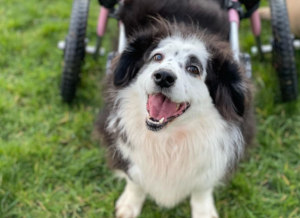Arthritis in dogs and Degenerative Myelopathy are two very different canine mobility disorders. Although the two conditions are vastly different, the early signs can be similar.
Does my dog have arthritis or degenerative myelopathy?
Both conditions start in a dog’s back legs and cause hind leg weakness. In the earliest stages of DM and arthritis, a dog may be unsteady on its feet and struggle to stand. However, that’s where the similarities stop.
Canine Pain: Arthritis vs. Degenerative Myelopathy
Canine Arthritis
Arthritis is a painful condition that can impact different joints in a dog’s body. A dog with arthritis may become less active and gain weight as moving becomes more painful. But most mobility loss from osteoarthritis is daily mild and easy to manage.
Osteoarthritis symptoms in dogs include:
- Slowing down with lower energy levels
- Sleeping more often
- Leg and joint stiffness
- Joints may appear swollen, and dog limps
- Difficulty jumping onto the couch, bed, or into the car
- Struggling on the stairs
- Slowly getting up off the ground
- Visible signs of pain, possibly shaking, panting, or licking joints
Degenerative Myelopathy
Degenerative Myelopathy, also known as DM, is a degenerative spinal disease, and although crippling, DM is not painful. DM is a serious canine mobility condition that severely impacts a dog’s ability to walk.
Symptoms of DM in dogs include:
- Loss of hind leg strength
- Knuckling, dragging, or walking on top of the back paw
- Muscle loss
- Falling over
- Crossing hind legs
- Incontinence
- Eventual paralysis.
Outcome and Prognosis
Degenerative Myelopathy causes progressive mobility loss that worsens and spreads over time. DM impacts a dog’s hind legs first before moving up the spine to affect the front leg strength. Unfortunately, there is no cure for DM paralysis is inevitable, and eventually, pets succumb to DM.
Pets diagnosed with arthritis have a much brighter outcome. Canine arthritis is highly treatable, and a veterinarian can easily manage a dog’s arthritis pain with medication and weight management. With proper care, an arthritic dog can expect to live a long life. In the most severe cases of arthritis, walking can be painful, and supporting the pet to reduce weight bearing on its back legs can make walking easier.


